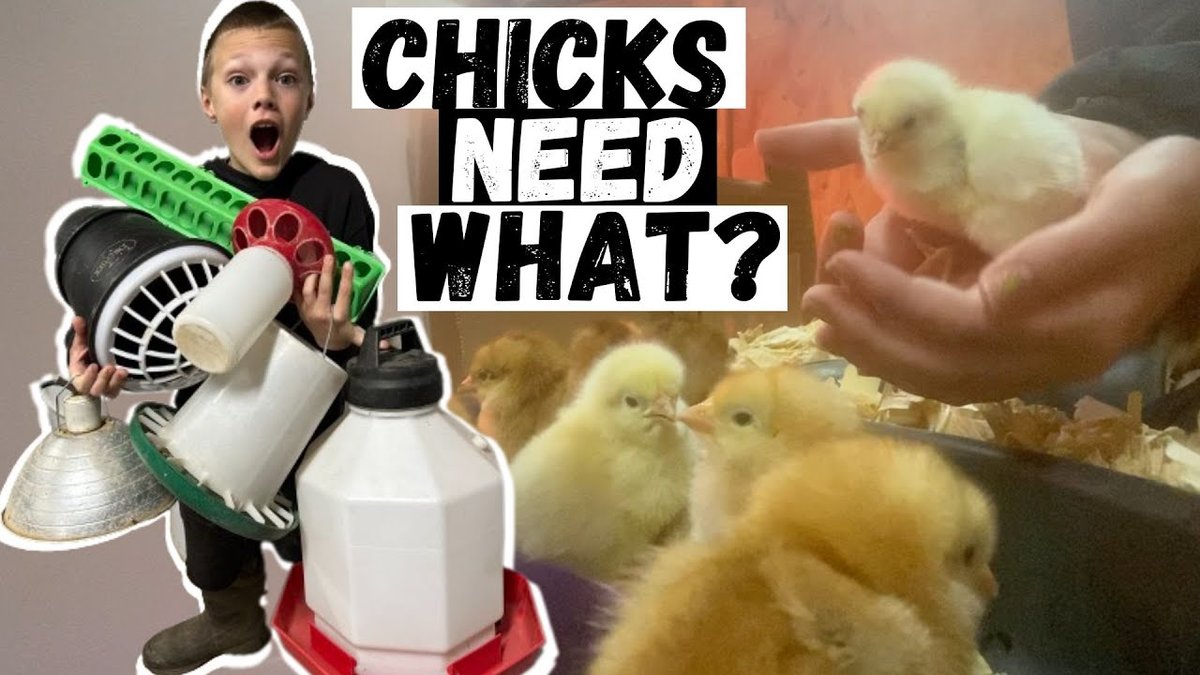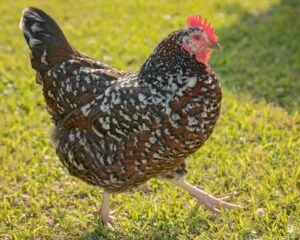The day you bring your first baby chicks home is an exciting milestone! The peeping sound and fluffy little bundles of energy are completely irresistible. It’s easy to get caught up in the excitement, but from my experience raising dozens of chicks over the years, I’ve learned that preparation is everything. A little work upfront ensures your new flock gets the best possible start in life.
This guide will walk you through everything you need, from setting up their new home to the essential supplies on your shopping list. We’ll also cover what you need to do when you first bring chicks home and how to care for them. Think of this as your complete, ready-for-anything chick preparation and management guide.
In a Hurry? Here’s Your Essential Shopping List:
- Brooder
- Heat Source (Plate or Lamp)
- Digital Thermometer
- Pine Shavings Bedding
- Chick Feeder
- Chick Waterer
- Chick Starter Feed
- Electrolytes & Vitamins
- Chick Grit
- “Pasting Up” Kit
- First-Aid Kit
- Biosecurity Supplies
- Brooder Lid/Cover
- Roosting Bars
- Entertainment (Mirror/Millet)
Keep reading for crucial details on how to choose and use each item!
First Things First: What a First-Time Chicken Owner Should Know
Before you even start shopping for supplies for your chickens, it’s important to understand the three core principles of raising healthy baby chicks: warmth, food and water, and safety. A tiny chick is completely dependent on you for all three. They can’t regulate their own body temperature for the first few weeks and are vulnerable to predators, illness, and injury. This checklist isn’t just a list of items to buy—it’s a plan to ensure your new chicks have everything they need to thrive and help you avoid the common mistakes every first-time chicken keeper makes.
Why Warmth is Non-Negotiable: A chick’s feathers don’t provide adequate insulation until they are several weeks old. Without a reliable external heat source, they will quickly get chilled, leading to sickness and a high risk of mortality. A chilled chick can’t properly digest food or water, and its immune system is compromised.
Why Food and Water Are So Specific: You can’t just throw any food or water at them. Chick food is specially formulated with the correct protein levels and nutrients for their rapid growth. Their water must be in a shallow container to prevent accidental drowning. A chick can die from dehydration in a matter of hours.
Why Safety is Paramount: Young chicks are completely defenseless. They can be trampled, attacked by household pets, or escape and get lost in your home. Their brooder must be a safe, secure fortress that protects them from any external threats and keeps them from getting into trouble.
Preparing for Arrival: Setting Up Your Brooder
The brooder is the safe, warm home for your chicks for the first four to six weeks. It’s where they’ll spend all their time, so setting it up before they arrive is absolutely critical. You want to make sure the temperature is perfect and the space is ready for them to move in as soon as you get them home.
1. The Brooder Itself (The Chicks’ New Home)
A brooder can be as simple or as complex as you want. The goal is to provide a draft-free, safe space that is easy to clean. I’ve used large galvanized stock tanks, plastic storage totes, and even large wooden boxes. The key is to make sure it’s big enough for the chicks to move away from the heat source if they get too warm and to be large enough for them for several weeks.
A good rule of thumb is to start with at least 0.5 square feet of space for every chick you have, then increase it to a full 1 square foot per chick after three weeks. Be prepared to upgrade to a larger space if you are raising a large flock.
2. A Reliable Heat Source (Heat Lamp vs. Heat Plate)
Chicks need supplemental heat until they grow their full feathers, which is around 4-6 weeks. The two most common options are a heat lamp or a heat plate.
- Heat Lamps: These are often the cheapest and most common option. They provide a broad heat area, allowing chicks to find the perfect spot. However, they use a lot of energy and, most importantly, are a significant fire hazard. You must secure them with a chain or clamp and keep them far away from flammable materials. Never use a “red” bulb, as it can disrupt a chick’s natural sleep cycle.
- Heat Plates: These are a fantastic, safer alternative. They are like a heating pad for chicks, mimicking the warmth of a mother hen. Chicks huddle underneath for warmth and can easily move away if they get too hot. They use less energy than a heat lamp and virtually eliminate the risk of fire. I’ve transitioned to a heat plate over the years and can’t recommend them enough for peace of mind.
3. A Digital Thermometer (Don’t Guess on Temperature!)
This is an absolute must-have. You can’t tell if the temperature is right just by looking at the chicks. The ideal temperature for the first week is between 90−95∘F (32−35∘C). Place the thermometer on the floor of the brooder, directly beneath the heat source, so you know exactly what the chicks are experiencing. You’ll lower the temperature by 5∘F (3∘C) each week until they no longer need the heat.
4. Proper Bedding (Keep it Clean and Dry)
Choosing the right bedding is key to preventing health issues. Pine shavings are an excellent choice because they’re absorbent and easy to clean. Avoid cedar shavings, as the oils can be harmful to a chick’s respiratory system. Never use newspaper or other slick surfaces, as it can lead to splayed leg, a condition where their legs slide out from under them and become permanently damaged. Another great option is hemp bedding, which is highly absorbent and great at controlling odor.
The Essential Baby Chick Checklist: Your Shopping List
Once the brooder is set up, it’s time to fill it with all the essentials. This is a list of the things you’ll need to have on hand before you even think about picking up your chicks.
Food and Water Supplies
5. A Chick Feeder: A simple, shallow plastic or metal feeder is perfect. The design prevents them from scratching all the food out, minimizing waste. For the first few days, you can even just sprinkle the food on a paper towel so they can easily find it.
6. A Chick Waterer: Water is a non-negotiable. A chick waterer is designed to be very shallow to prevent drowning. One trick I learned early on was to add clean marbles or stones to the base of the waterer to make it even safer. A small, one-quart waterer is plenty for a handful of chicks.
7. Day-Old Chick Food (Starter Crumbles): This is specially formulated for a chick’s nutritional needs, with a protein content of around 18-24%. It’s very finely ground, like a coarse powder, to make it easy for them to eat. You’ll often see two types: medicated and unmedicated. Medicated feed contains a preventative for coccidiosis, a common and potentially fatal parasitic infection in young birds. This is just one part of a comprehensive guide to feeding your chickens at every stage of life.
8. Electrolytes & Vitamins: These are especially useful for chicks that have been shipped long distances or seem a little lethargic. Adding them to their water for the first few days can help reduce stress and give them a boost. Look for a product specifically for poultry.
9. Chick Grit: If you give your chicks anything other than commercial chick starter (like treats or grass), they need chick grit to help them digest their food. It’s simply tiny, insoluble stones that help grind up food in their gizzard. If they are only eating starter crumbles, you do not need to provide grit. Understanding whether your chickens need grit or oyster shells becomes more important as they get older.
Health and Safety Supplies
10. A “Pasting Up” Kit: Pasting up is a condition where droppings get stuck to a chick’s vent, blocking it. It can be fatal if not treated. A small kit with a cup of warm water and a few cotton swabs or a soft cloth is all you need to gently clean them off. To treat it, hold the chick in your palm, use the warm water to soften the paste, and very gently remove it. Be careful not to pull the skin.
11. A Small First-Aid Kit: It’s always a good idea to have some basics on hand, like vet wrap for minor injuries or saline solution for cleaning wounds. Vetericyn Plus Poultry Care Spray is also a great product to have for cleaning minor cuts and scrapes. For a complete list of what to include, you can follow this guide on how to set up a chicken first-aid kit at home.
12. Biosecurity Supplies: Keeping your chicks safe from germs is crucial. Designate a pair of shoes just for the chicken area, and keep hand sanitizer or a wash station nearby. Biosecurity is the most important way to keep your flock healthy. This is especially important if you already have an older flock or visit other farms.
“Nice-to-Have” but Recommended Items
13. A Lid or Cover for the Brooder: Chicks, especially once they’re a few weeks old, can be surprisingly good jumpers. A sturdy lid or cover will prevent them from escaping and keep other pets out. A simple piece of hardware cloth or mesh secured over the top works great.
14. Roosting Bars: As early as two weeks old, chicks will start practicing their perching skills. Adding a small, low roosting bar helps them develop their leg muscles and satisfies their natural instinct to perch. A simple tree branch or a 2×2 piece of wood secured a few inches off the ground works perfectly.
15. Entertainment: Chicks are curious animals! A small mirror, a bell, or a millet spray can keep them occupied and happy. This is especially important if you have a very small number of chicks, as it helps to prevent boredom and pecking at each other.
What to Do When You First Bring Your Chicks Home
Setting up your brooder is the first step, but watching your chicks’ behavior will tell you everything you need to know about their comfort and health.
Reading Your Chicks’ Behavior (The “Brooder Thermometer”)
- Piled Up & Chirping Loudly: This means your chicks are too cold. They are huddling together for warmth.
- Spread Out & Panting: This means your chicks are too hot. They are trying to get away from the heat source.
- Moving Freely & Peeping Quietly: This is perfect! It means they are comfortable, healthy, and happy.
Common Health Issues and How to Spot Them
While most chicks are healthy, it’s important to be able to identify and address common problems quickly.
- Pasting Up: As mentioned above, this is when feces cling to the vent. It’s often caused by stress, overheating, or chilling. Always have your kit ready for this.
- Coccidiosis: A common parasitic infection. Symptoms include droopy chicks, lethargy, and bloody or watery droppings. Medicated feed helps prevent this. If you see signs of it, isolate the chick and learn when it’s time to call the vet for a backyard chicken.
- Dehydration: Chicks can dehydrate in hours. Lethargy, lack of appetite, and a sunken-in look are signs. Gently dip their beak in water to encourage them to drink. A vitamin/electrolyte solution can help.
- Splayed Leg: This is a condition where a chick’s legs spread out to the side, preventing it from walking. It’s usually caused by a slick brooder floor. It is treatable if you catch it early. You can use a small bandage or a small piece of string to gently hobble their legs together to help them heal.
The Next Step: Transitioning Chicks to the Outdoors
Your chicks won’t live in the brooder forever! The goal is to get them into their outdoor coop once they are ready. This usually happens between 5-8 weeks of age, depending on the breed and the weather. A big part of this transition is making sure you know how big your chicken coop should be to comfortably house your growing flock.
When Are They Ready to Move?
They are ready for the outdoors when they are fully feathered and the outside temperature is consistently above 50∘F (10∘C) at night. If you’re not sure, it’s better to wait an extra week than to risk chilling them.
Hardening Off Your Chicks
This is the process of gradually acclimating them to the outdoors. You can’t just move them from a warm brooder to a cold coop overnight.
- Daily Visits: Start by taking the brooder outside for short periods on warm, sunny days. This helps them get used to the sounds, smells, and temperatures of the outdoors.
- Remove the Heat: A few days before the big move, turn off the heat source in the brooder to let them get used to cooler temperatures.
- Move into the Coop: Choose a warm, sunny day for the final transition. Place their familiar feeder and waterer in the coop to help them feel comfortable.
Introducing Them to an Existing Flock
If you have older chickens, introducing a new, young flock requires a slow, careful approach. The pecking order is a real thing, and a new, small chicken can be severely injured or killed by an older bird.
- Side-by-Side Acclimation: Place the brooder (with a secure lid!) next to the main coop for a few days so the birds can see and get used to each other.
- Supervised Visits: Once the chicks are large enough (and you’ve transitioned them to the coop), allow the two groups to have supervised time together in the run.
- Roosting Separately: For the first few weeks, lock the new chicks in the coop at night and the older hens in the run (or vice versa) to prevent nighttime fighting.
Before You Buy: Planning Your Flock
Choosing which chicks to get is a big decision. Here are some key considerations to help you plan your ideal flock.
How Many Chicks Should You Get?
This depends on your goals and your local ordinances. A good number for a family who wants fresh eggs is 3-6 chickens. Of course, the cost to raise chickens for the first year can influence your decision. Most cities and suburban areas have limits on the number of chickens you can own. Be sure to check with your city’s regulations before you buy.
Broiler vs. Layer Chickens
- Layer Chickens: These are breeds specifically raised for egg production (e.g., Leghorns, Rhode Island Reds, Wyandottes). Finding the easiest chicken breed for beginners can make your first experience much more enjoyable. They are bred to live a long, healthy life and produce lots of eggs.
- Broiler Chickens: These are breeds raised for meat production. They grow extremely fast and are often ready for processing in 6-8 weeks. Broilers are not meant to live for a long time and will often suffer from health issues like heart problems if they are not processed. Make sure you know what type of chicken you are getting.
Sourcing Your Chicks: Hatchery vs. Local Feed Store
- Local Feed Store: The easiest way to get chicks. They usually have a variety of common breeds and the chicks have not undergone the stress of shipping. The staff can also answer any questions you have.
- Online Hatchery: This is a great option if you are looking for specific or rare breeds. The chicks will be shipped to you, and you will have a wider selection to choose from. Make sure you choose a reputable hatchery with good reviews.
Frequently Asked Questions (FAQs)
Do I need a rooster to get eggs?
No, you do not! Hens will lay eggs without a rooster. The eggs will not be fertile, so they will never hatch into a chick. We have a full article that explains in detail why you don’t need a rooster to get eggs. You only need a rooster if you plan to breed chickens.
How do I handle the chicks?
The best way to get your chicks used to being handled is to do it frequently and gently from a young age. Support them from underneath and avoid squeezing them. It can also help to sit in the brooder with them so they get used to your presence.
Can I give my chicks food scraps?
It’s best to stick to chick starter crumbles for the first few weeks to ensure they get all the nutrients they need for proper growth. Once they’re a bit older and have access to grit, you can offer small, bite-sized treats like oatmeal, plain yogurt, or some cut-up vegetables in moderation. It’s important to know what chickens can eat from your kitchen to keep them safe. Treats should never make up more than 10% of their diet.
How will I know when to switch them to a different feed?
You will typically switch your chicks from a starter feed to a grower feed around 8 weeks old, and then to a layer feed when they are close to laying eggs (around 16-20 weeks). Each type of feed has a different protein and calcium content to support their specific growth stage.
Can I raise chicks in the winter?
Yes, you can! However, you will need to be prepared to provide a much larger indoor brooding space since they won’t be able to go outside as early. You also need to be mindful of drafts and freezing water.
Which antibiotics are suitable for one-day-old chicks?
This is a question for a licensed poultry veterinarian. As a responsible poultry keeper, it’s crucial to understand that antibiotics should never be given as a preventative measure without a diagnosis. Doing so can lead to antibiotic resistance. If your chicks seem sick, the first step is to isolate them and contact a vet who specializes in poultry. The most common preventative measure for a specific illness (coccidiosis) is using medicated chick starter feed, which is not an antibiotic but an amprolium-based preventative.
What about day-old chick vaccination?
Many hatcheries offer a vaccination for Marek’s Disease, a common and serious poultry illness, for day-old chicks. When you order or buy your chicks, you should ask if they have been vaccinated. If you get them from a local feed store, the staff should be able to tell you. This is typically the only vaccination you need to worry about at this stage.
Final Words of Advice
Bringing home new chicks is a rewarding experience. As a new chicken owner, getting the right supplies and having a plan in place will make the transition smoother for both you and your new flock. Remember the three core principles: warmth, food, and safety. By having everything on this checklist ready to go, you’re setting them up for a healthy and happy life.

Oladepo Babatunde is the founder of ChickenStarter.com. He is a backyard chicken keeper and educator who specializes in helping beginners raise healthy flocks, particularly in warm climates. His expertise comes from years of hands-on experience building coops, treating common chicken ailments, and solving flock management issues. His own happy hens are a testament to his methods, laying 25-30 eggs weekly.



